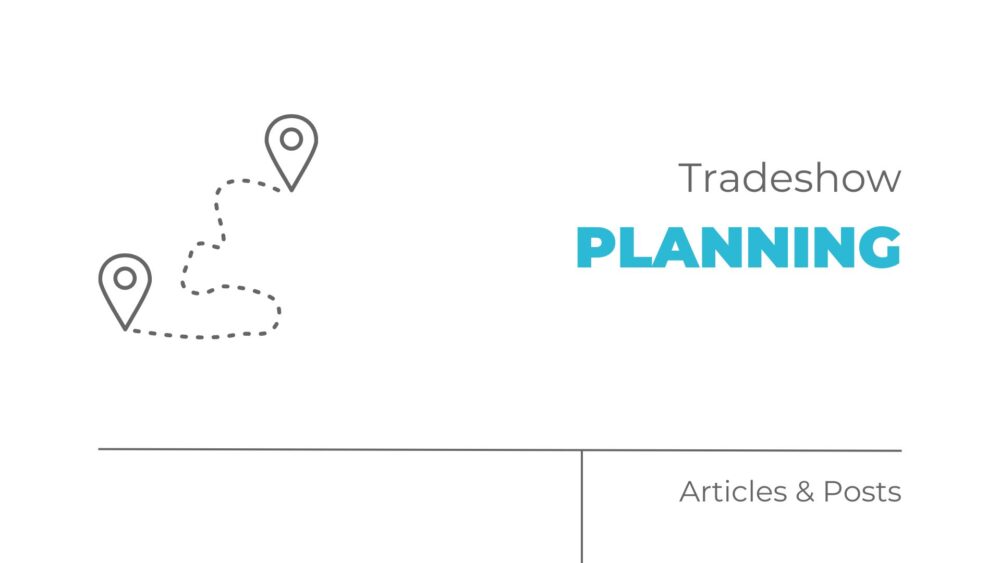Are you a marketing team or company gearing up to plan a tradeshow but feeling the crunch of time?
Tradeshow planning is no joke.
With strategic planning and the right support, you can pull off a successful event that leaves a lasting impression on attendees.
Let’s dive into the world of tradeshow planning, covering essential aspects, timelines, and checklists to ensure your event is a hit.
How Long Does It Take to Plan a Trade Show?
Before we delve into the nitty-gritty details, let’s address the burning question: How much time do you need to plan a tradeshow?
While the ideal timeline varies based on the scale and complexity of your event, a general rule of thumb is to allow at least six to twelve months for thorough planning.
However, if time isn’t on your side, there are still steps you can take to be successful!
With focused effort and support, you can expedite the process without compromising quality.
At Mock the Agency, we often work with companies and brands that are short on time and have a deadline to meet.
How Do You Plan a Trade Show Event?
Trade Show Planning Timeline
Certainly! Here’s a typical timeline for tradeshow planning, broken down into phases:
6-12 Months Before the Tradeshow:
1. Set Objectives and Goals: Define what you want to achieve from the tradeshow. Is it lead generation, brand awareness, product launch, or something else?
2. Budget Allocation: Determine your budget and allocate funds for various expenses such as booth rental, design, marketing, travel, and accommodation.
3. Research and Select Venue: Start researching potential venues that align with your target audience and budget. Once decided, book the venue well in advance to secure your spot.
4. Booth Design and Layout: Begin conceptualizing your booth design and layout. Consider factors such as branding, space utilization, interactive elements, and logistics.
5. Vendor Selection: Identify and select vendors for booth construction, signage, promotional materials, AV equipment, and any other services you may need.
6. Marketing Strategy Development: Develop a comprehensive marketing strategy encompassing pre-show, during-show, and post-show promotions. Utilize various channels such as social media, email, content marketing, and advertising to maximize visibility.
3-6 Months Before the Tradeshow:
1. Booth Construction and Design: Finalize your booth’s graphic design and begin the construction process. Work closely with graphic designers and vendors to ensure everything is on track for timely completion.
2. Staff Training: Train your booth staff on product knowledge, customer engagement techniques, lead capture methods, and any specific tasks they’ll be responsible for during the tradeshow.
3. Promotional Material Production: Order and produce promotional materials such as brochures, flyers, business cards, banners, giveaways, and branded merchandise. This can be specific to a city – like local Atlanta promotions, or nationwide.
4. Travel and Accommodation Arrangements: Make travel arrangements for staff attending the tradeshow, including flights, accommodation, transportation, and any necessary visas or permits.
5. Logistics Planning: Plan logistics for shipping booth materials, products, and promotional items to the tradeshow venue. Ensure everything arrives on time and in good condition.
3 Weeks to 1 Month Before the Tradeshow:
1. Finalize Booth Setup: Confirm all booth components, signage, displays, AV equipment, and promotional materials are ready and properly packed for transport to the tradeshow venue.
2. Review Marketing Collateral: Review and proofread all marketing collateral to ensure accuracy and consistency. Double-check contact information, branding, and messaging.
3. Staff Briefing: Conduct a final staff briefing to review roles, responsibilities, goals, and any last-minute instructions or updates.
4. Pre-Show Promotion: Ramp up pre-show promotion efforts to build anticipation and drive attendance. Send out reminders, teasers, and exclusive offers to your target audience.
During the Tradeshow:
1. Booth Setup: Arrive at the tradeshow venue early to set up your booth and ensure everything is in place before the show opens to attendees.
2. Engagement and Networking: Engage with attendees, demonstrate products, collect leads, and network with industry professionals to maximize the impact of your presence.
3. Attend Workshops and Sessions: Take advantage of any educational workshops, seminars, or sessions offered during the tradeshow to stay updated on industry trends and gather valuable insights.
Trade Show Planning Checklist
- Define clear objectives and goals.
- Establish a realistic budget and allocate funds accordingly.
- Select a suitable venue that aligns with your target audience.
- Design an attractive and interactive booth that reflects your brand identity.
- Develop a comprehensive marketing strategy to promote your participation.
- Train your staff to effectively engage with attendees and drive conversions.
- Coordinate logistics and operations to ensure a smooth event experience.
- Implement a post-tradeshow follow-up plan to capitalize on leads and feedback.
Seek Support and Delegate Tasks
While planning a tradeshow can be daunting, remember that you don’t have to go it alone.
Consider outsourcing certain tasks such as booth design, logistics coordination, or marketing support to specialized agencies or freelancers.
By leveraging external expertise, you can streamline the planning process, alleviate stress, and ultimately deliver a standout tradeshow experience for your audience.
At the End of the Day
Time may seem scarce, but strategic planning and the right support can empower your marketing team to execute a successful tradeshow that achieves your objectives and elevates your brand.
Embrace the challenge, stay organized, and don’t hesitate to seek assistance along the way.
With dedication and collaboration, your tradeshow endeavor is bound to be a resounding success!


Comments are closed.